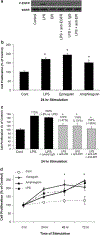Toll-like receptor 4 differentially regulates epidermal growth factor-related growth factors in response to intestinal mucosal injury
- PMID: 20498653
- PMCID: PMC10631458
- DOI: 10.1038/labinvest.2010.100
Toll-like receptor 4 differentially regulates epidermal growth factor-related growth factors in response to intestinal mucosal injury
Abstract
Epiregulin (EPI) and amphiregulin (AR) are epidermal growth factor receptor (EGFR) ligands implicated in mucosal repair and tumorigenesis. We have shown that Toll-like receptor 4 (TLR4) induces intestinal epithelial cell (IEC) proliferation by activating EGFR through AR expression. We examined whether TLR4 differentially regulates expression of EGFR ligands in response to mucosal injury. The human IEC line SW480 was examined expression of EGFR ligands, EGFR phosphorylation, and proliferation in response to lipopolysaccharide (LPS). Small-interfering RNA (siRNA) was used to block TLR4. Neutralizing antibodies to EGFR ligands were used to examine inhibition of LPS-dependent EGFR activation. Acute colitis and recovery were examined in the mice given 2.5% dextran sodium sulfate (DSS). Colonic secretion of EPI and AR was analyzed by enzyme-linked immunosorbent assay. LPS selectively induces EPI and AR but not other EGFR ligands. LPS induced early EPI mRNA expression between 30 min and 24 h. The neutralizing antibodies to EPI and AR prevented activation of EGFR by LPS. LPS induces IEC proliferation (200%, P=0.01) in 24 h but blocking EPI and AR significantly decreased proliferation. In vivo, mucosal EPI and AR expression are significantly decreased in TLR4(-/-) mice (P=0.02) compared to wild-type mice during acute colitis. EPI and AR exhibit different kinetics in response to mucosal damage: EPI expression is upregulated acutely at day 7 of DSS, but falls during recovery at day 14. By contrast, a sustained upregulation of AR expression is seen during mucosal injury and repair. We show that TLR4 regulates EPI and AR expression and that both these EGFR ligands are necessary for optimal proliferation of IEC. The diverse kinetics of EPI and AR expression suggest that they function in distinct roles with respect to acute injury vs repair. Our results highlight the role of bacterial sensing for IEC homeostasis and may lead to targeted therapy for mucosal healing and prevention of tumorigenesis.
Conflict of interest statement
DISCLOSURE/CONFLICT OF INTEREST
The authors declare no conflict of interest.
Figures




References
-
- Rakoff-Nahoum S, Paglino J, Eslami-Varzaneh F, et al. Recognition of commensal microflora by toll-like receptors is required for intestinal homeostasis. Cell 2004;118:229–241. - PubMed
-
- Abrams GD, Bauer H, Sprinz H. Influence of the normal flora on mucosal morphology and cellular renewal in the ileum. A comparison of germ-free and conventional mice. Lab Invest 1963;12:355–364. - PubMed
-
- Sartor RB. Clinical applications of advances in the genetics of IBD. Rev Gastroenterol Disord 2003;3(Suppl 1):S9–S17. - PubMed
-
- Kim SC, Tonkonogy SL, Albright CA, et al. Variable phenotypes of enterocolitis in interleukin 10-deficient mice monoassociated with two different commensal bacteria. Gastroenterology 2005;128: 891–906. - PubMed
Publication types
MeSH terms
Substances
Grants and funding
LinkOut - more resources
Full Text Sources
Molecular Biology Databases
Research Materials
Miscellaneous

